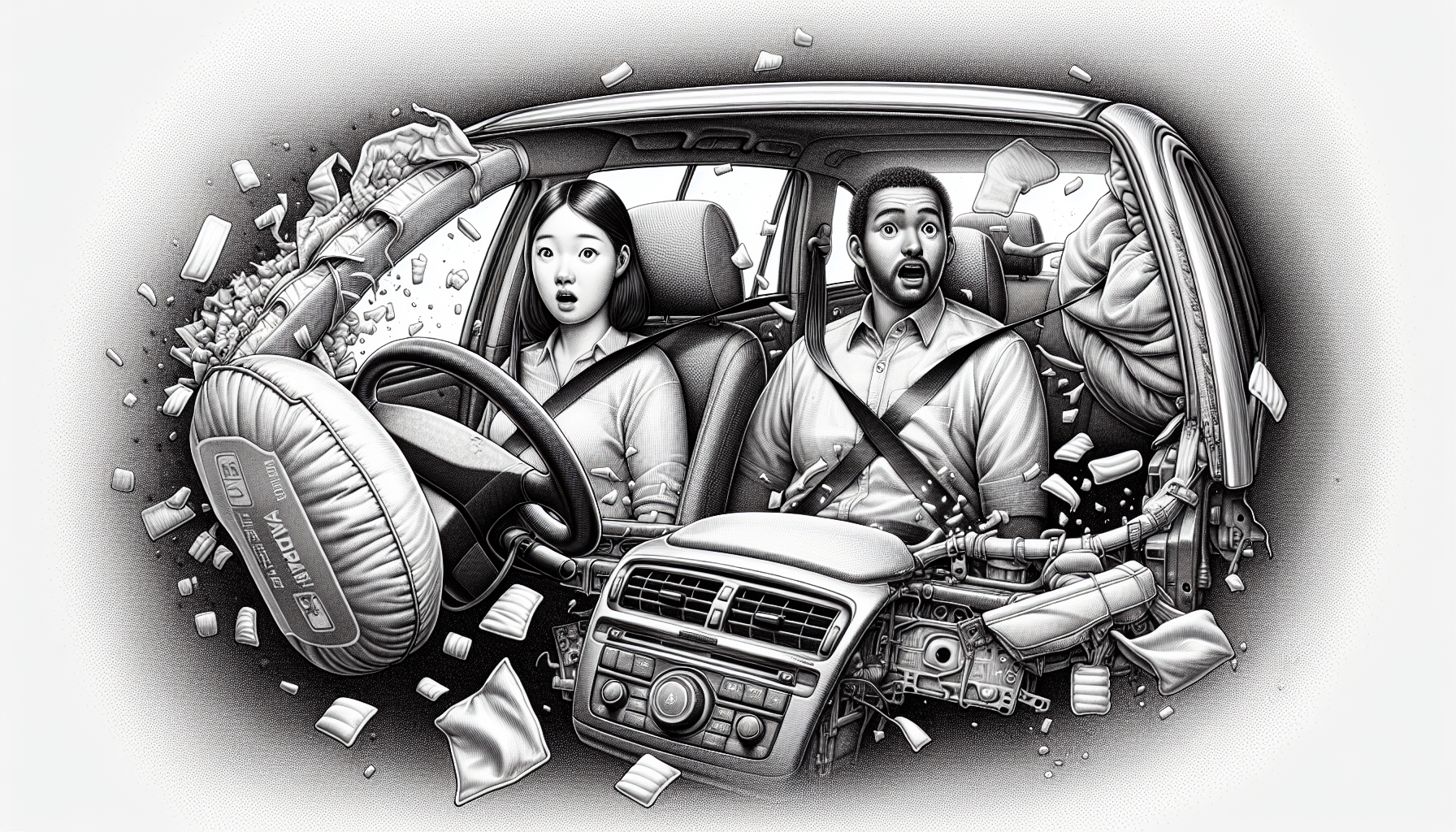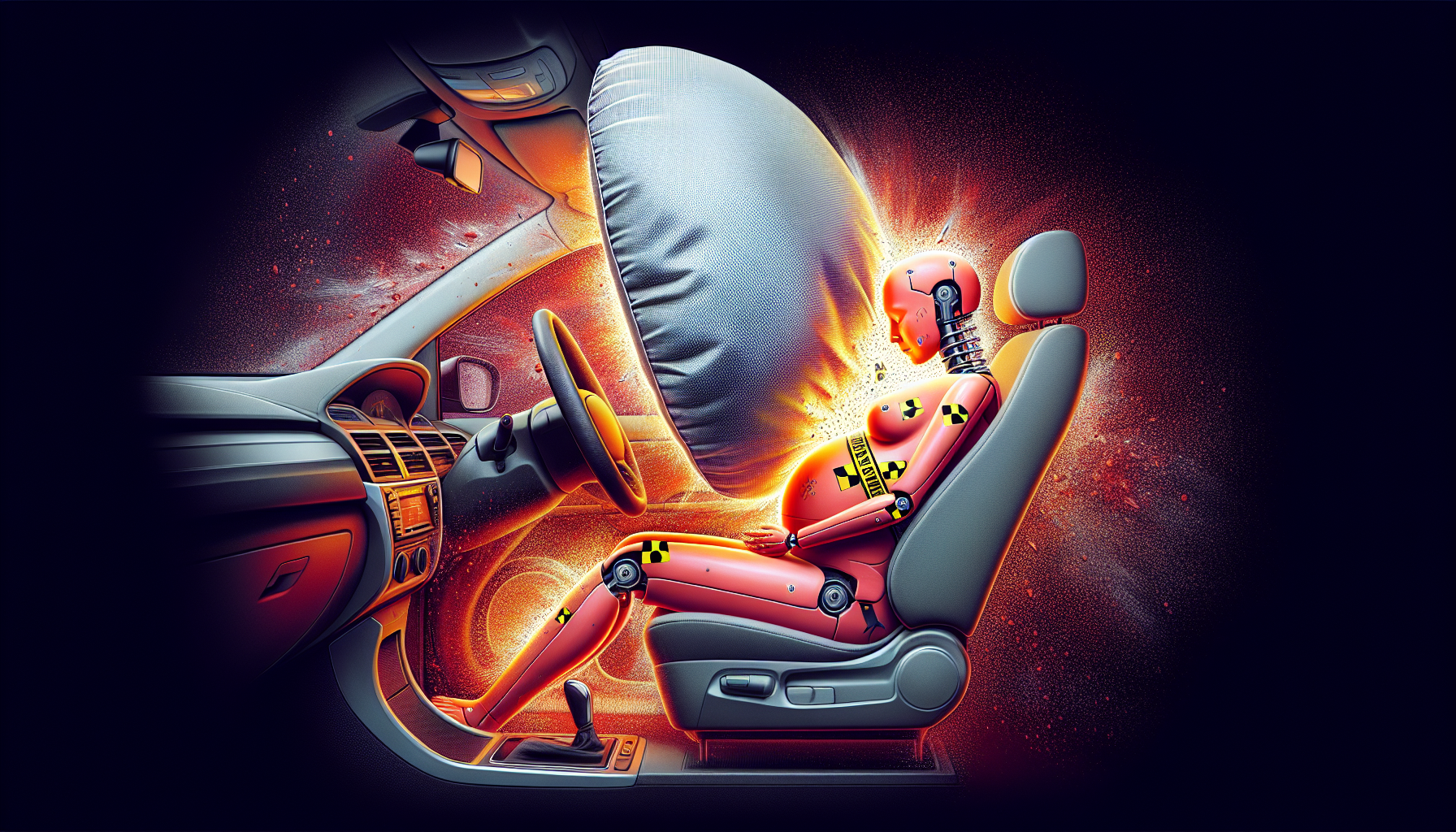Airbags are designed to shield you in a crash, but they can also inflict typical airbag injuries in a car accident. This article dives straight into understanding those injuries, their range from mild to severe, and what to expect if you or a loved one is affected.
Key Takeaways
Airbags save lives by cushioning vehicle occupants during impacts, but improper use or defects can lead to a range of injuries, from minor to severe, including head, facial, chest, and abdominal trauma.
Defective airbag materials, mis-timed deployment, and malfunctions can increase the risk of serious injuries or even death, emphasizing the importance of quality manufacturing and proper maintenance.
Victims of airbag injuries may seek legal recourse through personal injury claims, necessitating thorough documentation and legal representation to address complexities such as product liability and insurance company tactics.
Understanding Airbag Deployment and Its Impact on Vehicle Occupants

Airbags function through a complex sequence of events, cushioning vehicle occupants during sudden impacts and helping to save lives. Triggered by signals from the crash sensor, the control unit deploys the airbag in an astoundingly brief fraction of a second. This rapid action is influenced by factors such as collision severity and angle of impact.
Primarily, airbags prevent occupants from making forceful contact with the vehicle’s interior structures, thereby protecting the head and chest during moderate-to-severe frontal crashes. However, while airbags offer substantial protection, their deployment can potentially harm vehicle occupants. Hence, complementing airbags with proper seat belt use is essential as it ensures the occupant is optimally positioned for the airbag’s cushioning effect.
Despite their life-saving role, airbags can cause injuries, some of which are minor, while others are severe. These injuries, known as airbag injuries, are common in car accidents where the airbag deploys. Even cases of airbag malfunction or faulty airbags have been reported, leading to serious harm.
As a driver, understanding how airbags work and how to prevent airbag injuries can save you from the most common airbag injuries.
The Spectrum of Injuries Caused by Airbags: From Minor to Severe
Despite their protective role, airbags can cause a variety of injuries, ranging from minor abrasions to serious harm, and even fatal injuries in some cases.
Let’s delve into the specifics of these injuries, their implications, and how they can be managed.
Head and Brain Trauma: Not Just Bumps and Bruises
Head injuries resulting from airbag deployment aren’t merely superficial. They range from concussions and contusions to more severe forms of traumatic brain injuries (TBI). Brain injuries, even without skull fractures, occur in 3.83% of drivers and front-seat occupants in frontal crashes. Although skull fractures are rare, they pose a significant risk for brain injuries.
The impact of an airbag-related brain injury can be far-reaching, leading to long-term cognitive, emotional, and physical impairments. These injuries may alter a person’s life, necessitating long-term care and rehabilitation. Therefore, it is crucial to seek immediate medical attention following an accident, as timely intervention can minimize the potential impacts of head and brain injuries.
Facial Trauma: More Than Meets the Eye

Facial injuries are another common consequence of airbag deployment. These can range from lacerations and abrasions to facial fractures and, in rare cases, temporary or even permanent blindness. Facial fractures are common injuries from airbag impact, and they can result in broken facial bones, potentially leading to significant pain and disfigurement. Moreover, dental injuries, including fractured teeth and jaw injuries, can also occur due to the force of an airbag. Eye injuries can also result from the chemical powders released during airbag deployment.
If you experience any visible injuries or facial discomfort after an accident, it’s imperative to seek immediate medical attention. Prompt care can prevent lasting damage and ensure a smoother recovery process.
Chest and Abdominal Injuries: A Forceful Blow

Airbag deployment doesn’t just affect the head and face; it can also cause chest and abdominal injuries. These injuries can range from fractured ribs, contusions, and pulmonary contusion to more severe cases like emphysema and cardiac contusions. The force of an airbag can also inflict abdominal injuries ranging from seatbelt syndrome, lacerations to organs, and internal bleeding. These injuries can be particularly dangerous for pregnant women due to the risk of fetal trauma or miscarriage. Pregnant women and people who sit closer to the steering wheel or the dashboard require special attention because of the increased risk of severe injuries caused by the excessive force of the airbag.
Treatment for chest injuries, such as those resulting from airbag deployment, may include ice packs, anti-inflammatory medication, and rest. Some conditions, such as a broken sternum, may require weeks to months of recovery time.
When Airbags Cause More Harm Than Good: Malfunction and Defects
In some unfortunate instances, airbags can cause more harm than good. Faulty deployment and defective materials can lead to airbag deployment injuries, resulting in serious injuries.
Let’s delve into these scenarios and explore how they might occur.
Faulty Airbag Deployment Timing
The timing of airbag deployment is crucial for its effectiveness. However, faulty deployment timing can have dire consequences, such as increasing the severity of injuries during a car accident.
Cardiac injuries, including aortic transection or cardiac tamponade, as well as myocardial contusion, can be the result of the high-velocity deployment of airbags. Additionally, malfunctioning crash sensors can cause airbags to deploy prematurely in minor collisions or fail to deploy in severe accidents, leading to undue harm or inadequate protection.
The improper timing of airbag deployment, whether too early or too late, heightens the risk of serious injuries to vehicle occupants. Therefore, ensuring the proper functioning of airbags is crucial for the safety of vehicle occupants.
The Dangers of Defective Airbag Materials
The materials used in an airbag also play a pivotal role in its safety. Defective airbag materials can lead to a range of problems, from burns and hearing loss to respiratory issues. Defective airbags can explode during deployment, sending metal shards and shrapnel into the vehicle and causing serious injury. Furthermore, counterfeit and poorly manufactured airbags can greatly increase the risk of harm by either failing to deploy or exploding unexpectedly.
Manufacturing defects or material flaws in airbags can lead to compromised effectiveness and safety, potentially resulting in injuries. Therefore, ensuring the quality of airbags is crucial for the safety of vehicle occupants and the reputation of the airbag manufacturer.
Preventative Measures: Reducing the Risk of Airbag Injuries

While understanding the potential risks is important, it’s equally crucial to know how to reduce the chances of airbag injuries. There are several preventative measures that can be taken to mitigate these risks.
Passengers should maintain a proper seating position, sitting upright against the seatback with feet on the floor, and keeping at least a 10-inch distance from the dashboard or steering wheel. Shorter drivers should be especially cautious to maintain a safe distance due to the risk of injury from airbags, even though they may need to sit closer to reach the pedals.
Steering wheel hand positioning is crucial; occupants should keep both hands on the wheel to avoid the airbag flinging a limb into their face or causing breaks during deployment. Airbags provide the best protection when used in combination with seatbelts, as they are designed to be a secondary line of defense.
Advanced frontal airbag systems can adjust the deployment based on an occupant’s size, seating position, and seatbelt use, which enhances safety and reduces injury risks. However, non-use of seat belts can lead to significant injuries in the event of an airbag deploying, as it may cause the body to be incorrectly positioned, increasing the likelihood of severe impact.
It’s critical for passengers to avoid placing their feet on the dashboard; during airbag deployment, this could result in severe injuries from their feet being propelled toward their face. Also, avoid using aftermarket dash or seat covers, as they may impair airbag deployment or alter the path of deployment, potentially causing harm.
In specific cases where a rear-facing infant restraint must be placed in the front seat due to the absence of a rear seat, the NHTSA can authorize the installation of an ON-OFF switch to control airbag deployment. Children under 13 years of age should always ride in the back seat to avoid injury from frontal airbags, which are designed primarily to protect adult passengers.
Legal Recourse for Victims: Pursuing a Personal Injury Claim
If you’ve been unfortunate enough to suffer an airbag injury, it’s important to know that you have the right to seek legal recourse. This can involve:
Pursuing a claim under product liability laws
Suing for negligent design, construction, breach of express or implied warranty
Even if at fault, you may recover damages if the airbag was defective.
After an airbag injury, individuals should consult with personal injury attorneys to file an insurance claim, and if needed, proceed with a lawsuit for fair compensation; attorneys are essential when facing insurance company tactics that may undervalue the severity of injuries. Victims should pursue claims promptly when evidence is fresh to secure compensation for all losses directly attributed to a defective product; the process may be affected by factors such as not wearing a seatbelt, but is still possible.
Compiling the following documents is crucial for substantiating a personal injury claim following an airbag-related injury:
Medical treatment records
Lost income documentation
Injury photographs
Therefore, maintaining good records and obtaining legal counsel promptly can significantly impact your ability to receive fair compensation for your injuries.
Summary
Airbags play a crucial role in enhancing vehicle safety, but it’s essential to be aware of the potential injuries they can cause and the measures we can take to prevent them. By understanding how airbags operate, the injuries they can cause, and how to effectively reduce the risk, we can ensure safer journeys on the road.
Frequently Asked Questions
What does it feel like when an airbag deploys?
When an airbag deploys, it feels like a strong kick in the face, but you cannot manually deflate the bag.
What happens to your body when an airbag deploys?
When an airbag deploys, the high speed can cause injuries including broken bones, damage to soft tissue, burns, and lacerations, especially to the face and arms. Airbag deployment may result in irritant dermatitis and thermal burns, as well as various traumatic lesions such as abrasions and lacerations.
How bad does an accident have to be for airbags to deploy?
Airbags are designed to deploy in moderate to severe crashes, which can be as low as 10-16 mph. Even low-speed crashes can be devastating, so it's important to stay cautious on the road.
What is the most common injury from airbags?
The most common injury from airbags is facial injuries, such as abrasions, lacerations, fractures, and broken bones. It's important to be aware of the potential risks associated with airbag deployment.
How do airbags work?
Airbags work by deploying in a fraction of a second when crash sensors signal a sudden impact, cushioning vehicle occupants during accidents.

